Imagine you’re standing on a coastline, looking out into the ocean. Something shifts, and from your vantage point, it seems like the sea-level has risen. There are two possible changes that could have caused this: either the sea level has actually risen, or the land you’re on could have sunk.
The combined effect of changes in sea level and land height is termed "relative sea level." As we navigate the challenge of rising sea levels, having accurate measurement techniques is essential.
This article outlines three methods to monitor relative sea-level that are used by scientists from the Earth Observatory of Singapore (EOS): tide gauge, Global Navigation Satellite Systems, and Synthetic Aperture Radar.
Why do we need so many methods? Well, the dynamics of relative sea level are complex. Each technique offers unique insights into the complex phenomenon of sea-level change, and several techniques are often used in combination for the most robust results.
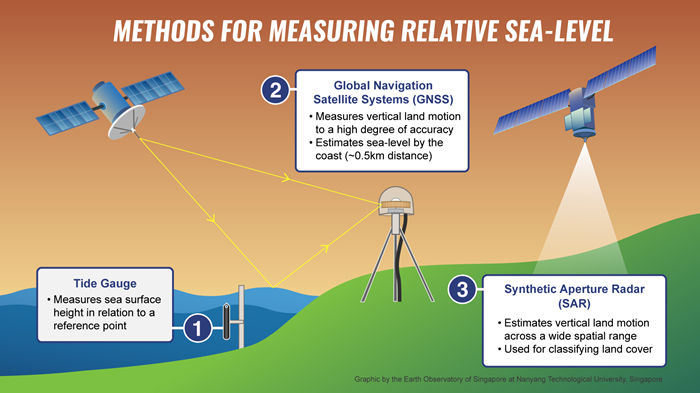
Three methods commonly used to estimate relative sea level (Source: Jae Ng and Jay Wong/Earth Observatory of Singapore)
-
Tide Gauge: the tried-and-tested method of measuring sea-level
Tide gauges are instruments that measure sea level in relation to a reference point. They come in many forms, ranging from a simple vertical staff that resembles a ruler, to a more sophisticated instrument like the pressure gauge, which estimates sea level through hydrostatic pressure.
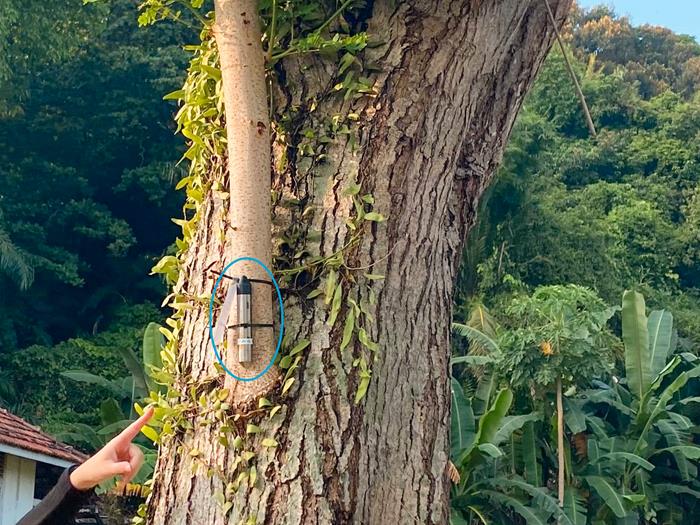
Pressure gauges are small but powerful instruments. Pictured is a pressure gauge installed at St John Island by the sea-level and earthquakes research group (Source: Yeo Jing Ying/Earth Observatory of Singapore)
As tide gauges have been in use for decades, they provide long-term historical data that are crucial for understanding long-term sea-level variations. In Singapore, tide gauge records at Sultan Shoal and Sembawang trace back as far as the 1970s. The data from 6 tide gauges around Singapore were used to estimate past and future sea-level projections for Singapore in the third National Climate Change Study.
While tide gauge records remain crucial for studying sea level, they are frequently complemented by other instruments to address limitations in spatial coverage and the requirement for ground data.
-
Global Navigation Satellite Systems (GNSS): gathering data from both land and sea
GNSS, such as the Global Positioning System (GPS), are widely known for their positioning capabilities, which can be used to track movements of the ground, and estimate land subsidence at specific locations.
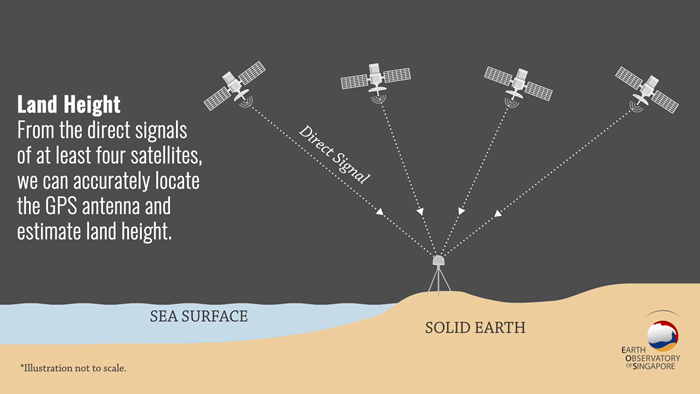
GNSS stations are typically built on a stable, solid surface. By leveraging GNSS’ positioning capabilities, scientists can accurately measure changes in land height (Source: Nguyen Thi Nam Phuong and Jay Wong/Earth Observatory of Singapore)
Beyond measuring land movement, scientists have also developed an innovative technique to estimate sea-level changes, known as GNSS Interferometric Reflectometry (GNSS-IR). By analysing the reflections of satellite signals off water surfaces, GNSS-IR can accurately measure sea-level variations.
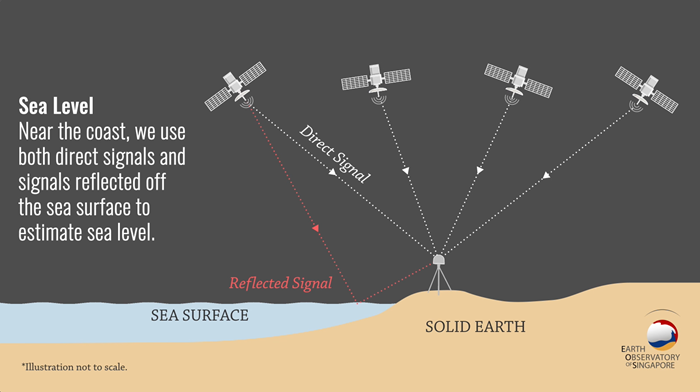
GNSS can be used to measure changes in sea level (Source: Nguyen Thi Nam Phuong and Jay Wong/Earth Observatory of Singapore)
Since GNSS and GNSS-IR can be used to measure both vertical land motion and sea surface height, the use of GNSS technology addresses the limitations of tide gauges, which lack data on vertical land motion. Furthermore, GNSS-IR is able detect changes in the sea surface across a greater distance compared to a tide gauge - up to 0.5 kilometres away from the coast.

The use GNSS-IR is being explored on Singapore’s shores, with dedicated stations being built around our coastlines, starting with Lazarus Island. This station is a collaboration with Singapore Land Authority, and is part of the SiReNT network. (Source: Jay Wong/Earth Observatory of Singapore)
EOS scientists have used GNSS-IR in combination with tide gauges to analyse seasonal sea-level changes in Singapore. In this study in collaboration with Singapore Land Authority, both methods are used to increase the spatial coverage of the study.
For even further spatial coverage, EOS scientists have also turned to remote sensing, through the use of a technology called Synthetic Aperture Radar.
-
Synthetic Aperture Radar: round-the-clock and round-the-world monitoring
SAR is a remote sensing technology that generates high-resolution images of the Earth's surface. SAR can be used to measure land-height change and the monitor of coastlines, which contribute to the understanding of relative sea-level dynamics.
One notable technique within SAR is Interferometric SAR (InSAR), which allows scientists to compare the differences in signal travel times over time and estimate changes in vertical land motion across large spatial areas. This approach has been effectively employed by EOS scientists in the study of land subsidence of coastal cities around the world.
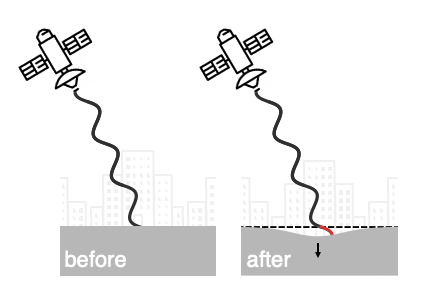
Interferometric Synthetic Aperture Radar (InSAR) can be used to measure changes in land height by calculating the change of the distance between the satellite and the ground (Source: Cheryl Tay/Earth Observatory of Singapore)
Beyond its role in detecting land-height changes, SAR also offers the capability to classify land cover. By analysing the reflected SAR signals, scientists can monitor coastlines and better understand the impacts of sea-level rise on coastal communities. This helps facilitates effective coastal management and planning.
SAR data is typically validated by referencing other datasets, such as GNSS.
In summary, the discussed methods underscore the need for a comprehensive approach to studying sea level dynamics. By combining these diverse techniques, researchers can gain a more nuanced understanding of sea-level changes, enabling better-informed decision-making in the face of rising sea levels and climate change.
Stay tuned for more—in an upcoming blogpost, we will be discussing nature-based methods of tracking historical sea level!